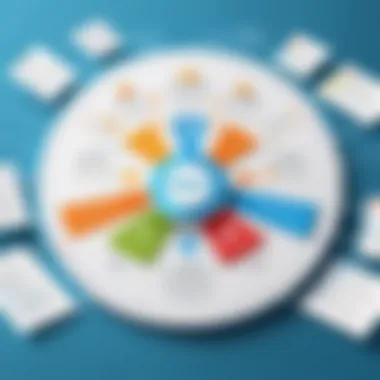Exploring the Coggle Website: A Comprehensive Review


Intro
In the digital age, effective collaboration and brainstorming tools are essential for individuals and teams. One such tool is Coggle. It stands out because it enables users to create mind maps effortlessly. Mind mapping itself is a method that helps in visually organizing information. This article explores Coggle's functionality, its strengths, and how it compares to other tools in the market.
Overview of Software
Description of Software
Coggle is a web-based mind mapping software. It provides a platform where users can visually arrange ideas and concepts. The interface is clean and user-friendly, making it suitable for various skill levels, from beginners to advanced users. The primary goal is to enhance productivity through better idea management.
Key Features
Coggle offers several features that aid in effective mind mapping:
- Real-time collaboration: Multiple users can work on the same map simultaneously. This makes it great for teams.
- Easy sharing options: Users can share their maps via links or embed them into other platforms.
- Image and file uploads: Users can enhance their maps by including images and documents, providing richer context.
- Version history: A feature that allows users to track changes and revert to previous versions if necessary.
- Diverse templates: Coggle offers various templates, making it easier to start new projects without beginning from scratch.
Software Comparison
Comparison with Similar Software
When comparing Coggle with other mind mapping tools, it is important to identify key competitors. Tools such as MindMeister, XMind, and Lucidchart come to mind. Each of these has its own unique features. For instance, MindMeister excels in presenting maps visually. XMind offers a more extensive range of formats and styles. However, Coggle's simplicity and focus on collaboration often give it an edge for teams working in real time.
Advantages and Disadvantages
Advantages
- User-friendly interface: New users can easily navigate the site without needing extensive training.
- Collaborative features: Ideal for teams, as it promotes collective brainstorming.
- Integration with Google Drive: This allows users to save and share their work seamlessly.
Disadvantages
- Limited offline capabilities: Coggle requires an internet connection for most functions.
- Subscription cost: While there is a free version, the most useful features are locked behind paywalls.
"Collaboration becomes significantly easier with tools like Coggle, which prioritize user engagement and shared creativity."
Foreword to Coggle
Coggle has become an essential tool for professionals and teams who require effective mind mapping solutions. In this section, we will explore what Coggle offers and how it fits into the broader context of mind mapping tools. Mind mapping is not just a method of organizing thoughts; it is a technique that enhances creativity and improves understanding of complex subjects. Coggle stands out due to its collaborative features and user-friendly interface, making it a strong candidate for both individual users and larger teams.
Coggle's significance lies in its ability to facilitate brainstorming sessions and project planning. The mind map created can serve as a visual representation of ideas, aiding memory retention and making connections evident. Understanding this tool is crucial for anyone looking to enhance productivity through organized thought processes.
Understanding Mind Mapping
Mind mapping is a visual method of note-taking that allows individuals to capture ideas and connect them in a structured way. Unlike traditional note-taking, where ideas are laid out linearly, mind mapping encourages a more holistic approach. It promotes engagement with the material, resulting in better retention. With tools like Coggle, users can create, modify, and share mind maps quickly and easily. This flexibility allows users to adapt their thinking and collaborate effectively.
When applied to projects, mind maps can help articulate tasks, timelines, and responsibilities. They serve as a roadmap guiding teams on what needs to be done and when. This clarity can significantly improve project execution and reduce misunderstandings among team members.
The Role of Coggle in Mind Mapping
Coggle serves as a pivotal platform in the realm of mind mapping. The website provides users with a straightforward interface that allows even the most novice users to create intricate mind maps with little effort. Its collaborative tools are particularly noteworthy, enabling multiple users to contribute simultaneously. This encourages teamwork and the pooling of diverse ideas.
Coggle also offers various features that enhance the mind mapping experience:


- Easy navigation through branches and sub-branches for better organization
- The ability to add images and links, enriching the map content
- Different color options to distinguish categories visually
- Export options allowing users to save maps in formats like PDF or image files
Features of the Coggle Website
The features of the Coggle website are pivotal for anyone looking to streamline their mind mapping processes. This section will dissect what makes Coggle stand out among other mind mapping tools. The specific elements of Coggle facilitate not just individual creativity, but also collaborative efforts, making it beneficial for both small teams and larger organizations. A clear understanding of these features allows users to maximize their experience, leading to enhanced productivity and better organization of ideas.
User Interface and Experience
Coggle's user interface is one of its strong suits. The layout is intuitive. Users can easily navigate through the various functionalities without a steep learning curve. The main focus is on simplifying the mind mapping process. Nodes can be easily added, modified, and connected. The use of color coding and icons makes the interface visually appealing while also providing quick recognition of different ideas and branches. This simplicity does not sacrifice functionality.
Many users have noted that the visual aspects of Coggle contribute positively to their engagement with the content. The seamless design encourages exploration, which is crucial for creative processes. Moreover, whether on a desktop or tablet, the responsiveness of the site enhances the overall experience. A well-designed interface means that ideas can flow freely without technical hassles.
Collaboration Tools
Collaboration is a core aspect of Coggle. The platform provides real-time editing, allowing multiple users to work on the same mind map simultaneously. This feature is especially useful for teams that strive for cohesive brainstorming sessions. Changes made by one user are instantly visible to others, fostering a dynamic environment.
Additionally, Coggle supports comments. Users can leave insights and suggestions directly on the mind map. This function encourages detailed discussions, making it easier to integrate diverse viewpoints. The ability to share maps via links or invitations makes collaboration hassle-free, overcoming the limitations that traditional mind mapping may impose.
Integration with Other Software
Coggle integrates well with various software solutions. This aspect is critical for professionals who rely on multiple tools for their workflows. Users can embed maps into platforms like Google Docs or export them to formats like PDF and image files. This versatility enhances its functionality, as it allows Coggle to complement existing processes.
Such integrations ensure that unifying various aspects of projects is straightforward. By linking to tools like Trello or Slack, teams can maintain consistent communication and project management standards while utilizing Coggle for brainstorming and organization.
Customization Options
Customization is another highlight of Coggle. Users can personalize their maps with colors, shapes, and fonts. This flexibility allows users to design mind maps that align with their personal or corporate branding. Such features not only appeal to aesthetics but significantly improve usability.
This personalized experience makes Coggle an attractive option for businesses. Tailoring maps to specific styles can enhance presentations, making them engaging for an audience. Detailed customization can reflect the nature of the project or the preferences of the team, fostering a stronger sense of ownership among contributors.
Exporting and Sharing Maps
Coggle provides various exporting and sharing options. Users can export mind maps in multiple formats. This flexibility allows them to easily share ideas with stakeholders who may not use Coggle. The ability to convert maps into PDFs or image files also ensures that the information remains accessible offline.
Sharing maps is streamlined through link generation, enabling easy distribution. Users can control privacy settings, deciding whether a map should be public or accessible only to specific individuals. This feature balances collaboration with confidentiality, allowing users to dictate the visibility of their work.
"The diverse features of Coggle not only foster creativity but also enhance workflows, providing a robust tool for both individual and collaborative projects."
In summary, the features of the Coggle website create an effective environment for mind mapping. The combination of a user-friendly interface, collaboration options, software integrations, customization capabilities, and versatile sharing methods enhances the overall utility of Coggle for various professional needs.
User Insights and Testimonials
User insights and testimonials hold significant relevance in the exploration of the Coggle website. They provide authentic feedback from actual users, offering a depth of understanding that cannot be captured through feature lists alone. By engaging with user experiences, potential users can gauge not only the functionality of Coggle but also its practical applications in various contexts. Testimonials highlight the strengths and limitations of the platform, shedding light on real-world usage scenarios.
Gathering insights from users allows for a more nuanced view of Coggle's effectiveness in mind mapping tasks, especially in collaborative environments. Users often share specific situations where Coggle excelled or faced challenges, thus painting a richer picture of its operational dynamics. Such information is vital for helping prospective users make informed choices based on their specific needs and expectations.
User Experiences with Coggle
Many users share positive experiences regarding Coggle's intuitive design and user-friendly interface. They appreciate the platform’s simplicity, allowing them to create mind maps without steep learning curves. A review from a software project manager highlighted, "Coggle helped our team visualize complex project details easily. The flow was logical and straightforward."
Furthermore, collaborative features receive favorable mentions. Users find value in real-time editing capabilities, as shown in comments like, "The ability to work simultaneously with my colleagues has made our brainstorming sessions more productive."


However, not every user experience is overwhelmingly positive. Some users express frustration over limited export options, which can hinder usability for offline work. It is noted that while Coggle provides essential tools, it may not meet every advanced need out there.
Pros and Cons of Using Coggle
In evaluating Coggle, it is essential to balance its advantages against its drawbacks. The following points summarize the key pros and cons:
Pros:
- Ease of Use: Users appreciate the straightforward navigation and design of the platform.
- Real-time Collaboration: Teams can work together seamlessly, enhancing productivity.
- Visual Appeal: Mind maps created are visually engaging and easy to interpret.
- Web-Based Functionality: Accessibility from any device with internet connectivity is a significant benefit.
Cons:
- Limited Features in Free Version: The free plan provides basic functionalities, but many features are locked behind the paid tiers.
- ** Export Options:** Some users report that exporting maps to certain formats is cumbersome or limited.
- Performance Issues: A few users have noted lag during extensive mapping activities, particularly in larger projects.
It is clear from user testimonials that Coggle excels in simplicity and collaboration but has room for improvement in advanced features and performance.
Comparative Analysis with Other Mind Mapping Tools
In the ever-evolving landscape of digital mind mapping, understanding how Coggle stacks up against its peers is critical. Mind mapping plays a significant role in organizing thoughts and facilitating collaboration. Each tool offers unique features, strengths, and weaknesses that can affect user experience. A comparative analysis is not only beneficial for discerning users but also crucial for making informed decisions.
Evaluating these tools allows users to identify which features are most aligned with their specific needs. For instance, pricing structures can greatly vary between tools. Additionally, some platforms may excel in collaboration while others focus more on visual aesthetics. This comparative analysis will help users ascertain the value each tool brings to the table, guiding them towards the best fit for their requirements.
Coggle vs. MindMeister
Coggle and MindMeister are both prominent players in the field of mind mapping. Coggle is known for its simplicity and user-friendly interface. The visual appeal of Coggle enhances user experience, particularly for those who favor minimalist design. On the other hand, MindMeister offers robust project management features. It supports task assignments and deadlines, making it more suited for team projects.
In terms of collaboration, MindMeister has an advantage with its real-time editing capabilities. Users can see changes as they happen, facilitating seamless teamwork. However, Coggle allows for unlimited image uploads even on free plans, which can be a significant draw for creative users. Ultimately, the choice between these two often hinges on the user’s specific priorities—be it simplicity or comprehensive project management.
Coggle vs. XMind
XMind and Coggle target differing user bases. XMind is particularly strong in offering advanced features such as Gantt charts and spreadsheets for project planning. This tool is versatile and appeals to users who seek in-depth analytical capabilities. Coggle simplifies the process with an emphasis on rapid mind map creation and sharing.
Importantly, XMind allows exporting to various formats, including PDF and Word. This flexibility can be crucial for users needing to share information externally. However, Coggle shines in the user experience department. Its easy navigation and uncluttered design make it enjoyable for users who prefer a straightforward approach to mind mapping. Users must weigh the need for advanced features against the ease of use offered by each platform.
Coggle vs. Lucidchart
When compared to Lucidchart, Coggle stands out in mind mapping simplicity while Lucidchart positions itself as a comprehensive diagramming tool. Lucidchart supports a wider variety of diagramming needs beyond mind maps, including organizational charts and flow diagrams. This makes it a robust choice for users needing multifunctional capabilities.
Coggle's strength lies in its ease of use and visual clarity. It provides a straightforward way to create and share mind maps with minimal learning curve. However, Lucidchart requires a bit more time to grasp, especially for new users. It also offers template support, which helps speed up the creation process for complex diagrams.
In summary, users need to consider what type of projects they are working on. If the goal is straightforward mind mapping, Coggle may be the best fit. If a user requires extensive diagramming options, Lucidchart might offer greater value.
The choice of a mind mapping tool ultimately depends on user preferences, project requirements, and collaboration needs.
This comparative analysis has highlighted critical differences and similarities among Coggle, MindMeister, XMind, and Lucidchart. Gaining a clear perspective on each tool is essential for IT professionals, software professionals, and businesses of any size looking to optimize their mind mapping endeavors.
Pricing and Subscription Plans
Understanding the pricing structure of Coggle is crucial for potential users. It allows individuals and businesses to evaluate whether the software aligns with their needs and budget. Evaluating the pricing can highlight the features and functionality essential for effective mind mapping. The availability of various subscription options supports different user requirements, making it a flexible tool in the productivity space.
Free vs. Paid Features


Coggle offers a free tier that serves as a valuable introduction to its capabilities. Users can create an unlimited number of mind maps, which is a significant advantage for those wanting to explore the platform without financial commitment. However, this free version has certain limitations.
- Limitations of Free Tier: Users are typically restricted in terms of the number of image uploads and advanced features. For example, real-time collaboration is limited, and exporting options are not as extensive as in paid subscriptions.
- Paid Features: Upgrading to a paid plan unlocks additional features like higher image upload limits, advanced export formats, and priority support. Users can also enjoy unlimited collaborators on a single mind map, enhancing teamwork capabilities significantly.
Overall, understanding these differences helps users determine the best fit based on how they intend to use Coggle for mind mapping tasks.
Value for Money Assessment
When considering the value for money of Coggle, one must weigh the benefits against the cost of each subscription tier. Coggle's subscription plans cater to different user segments:
- Individual Users: The Individual plan is often seen as reasonably priced, especially considering the plethora of features it includes compared to other mind mapping tools.
- Team and Business Plans: For teams, the costs are justified by enhanced collaboration tools, such as real-time editing and comprehensive management features for projects. The ability to work simultaneously on a mind map increases productivity, solidifying the software's value.
"Investing in the right tools can result in enhanced productivity and efficiency for teams, making Coggle not just a software choice but a strategic investment."
Additionally, planned updates and continued improvement in user experience make Coggle's paid plans more compelling. Users can expect a reliable return through increased productivity and better organization of information in their projects.
Best Practices for Using Coggle
Using Coggle can greatly enhance productivity and creativity, particularly in the realm of mind mapping. To fully leverage its capabilities, it's essential to be aware of best practices tailored to optimize your experience. Whether you are a seasoned professional or a newcomer, understanding these practices can significantly elevate the quality of your mind maps and collaborative projects.
Creating Effective Mind Maps
Creating effective mind maps using Coggle involves strategic thinking and clarity of vision. Start by selecting a clear main idea or topic. This central concept serves as the foundation for your map. Here are some key guidelines for crafting your mind maps:
- Use clear, concise labels for each branch to make them meaningful and easy to understand.
- Incorporate visuals such as images or icons. Visual elements enhance engagement and can help communicate ideas more effectively.
- Employ a hierarchical structure. Organize branches to reflect the relationships between different ideas. This structure clarifies connections and paths of thought.
- Limit the number of branches at each level. Too many branches can lead to clutter, making it difficult to process information.
To sum up, effective maps should be organized, visually appealing, and formatted for easy comprehension. This will not only facilitate your own understanding but also aid others who may view your work.
Maximizing Collaboration Features
Coggle shines in its collaborative functions. To maximize these features, consider the following strategies:
- Invite team members early in the process. Engaging collaborators from the start fosters collective idea generation and allows for real-time feedback.
- Utilize comments and chat features. These tools let you leave notes, ask questions, and express thoughts directly on the mind map. This persistent dialogue can clear up misunderstandings quickly and promote a more cohesive workflow.
- Establish roles and responsibilities. If you are working with a team, clarify who is responsible for which sections of the map. This decreases overlap and enhances accountability.
- Document changes and revisions. Coggle automatically saves previous versions. Regularly review these changes to track the evolution of ideas.
Effective collaboration can greatly accelerate project timelines and improve the quality of outcomes. When everyone has input, the result is richer and more diverse.
The End and Recommendations
In concluding our comprehensive review of Coggle, it is crucial to distill the insights acquired throughout various sections of the article. Coggle serves as a robust tool for mind mapping and enhances collaboration among users. Its ability to facilitate brainstorming and consolidate thoughts into visual formats is commendable. The integration capabilities with other platforms such as Google Drive and the ability to easily export maps further solidify its position as a valuable asset.
While navigating the user interface may seem straightforward, its features offer a significant depth for effective organization and project management. Comparatively, Coggle stands its ground against competitors, providing unique strengths that appeal to specific user requirements.
Final Thoughts on Coggle
Coggle is more than just a tool for mind mapping; it embodies a philosophy of collaborative creation and visual organization. The simplicity of usage juxtaposed with powerful features makes it suitable for individuals seeking to elevate their brainstorming sessions. Whether in creative fields or structured business environments, Coggle adapts well.
Key highlights of Coggle include its real-time collaboration capabilities, making it easier for teams to work together regardless of geographic barriers. Users can visualize complex ideas and facilitate discussions in a manner that traditional text lacks. Given the extent of its functional attributes, it is an appealing choice.
"Adopting a product like Coggle is akin to embracing a modern approach to ideas—visual, collaborative, and efficient."
Who Should Use Coggle?
Coggle is ideally suited for various segments of users. First, IT professionals can use it to design workflows, document systems, or map out project roadmaps. The visual nature allows for clear communication of complex IT concepts.
Second, software professionals can benefit from structuring project ideas, developing strategies, or troubleshooting processes that require a visual representation of information.
Finally, small and large businesses alike will find value in Coggle's ability to enhance team collaboration and optimize planning sessions. Those involved in strategic development or marketing can utilize Coggle to visualize campaigns, track projects, or create presentations that engage stakeholders.















